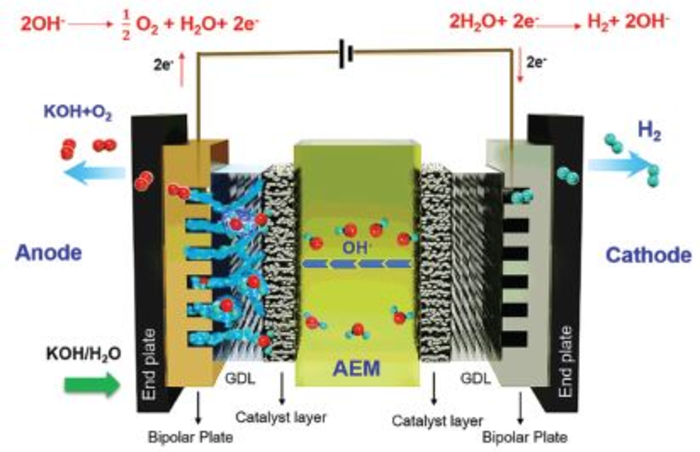Over the past few years, considerable attention has been given to hydrogen as a potential clean energy resource that can serve as an alternative to fossil fuels.
 Schematic diagram of the AEMWE, where the catalyst layer consists of ionomers and catalysts. Image Credit: Korea Institute of Science and Technology (KIST).
Schematic diagram of the AEMWE, where the catalyst layer consists of ionomers and catalysts. Image Credit: Korea Institute of Science and Technology (KIST).
Specifically, there has been an active study and development of water electrolysis technology that removes hydrogen from water to generate green energy and shuns the emission of greenhouse gases.
The proton exchange membrane water electrolyzer (PEMWE) technology, presently existing in a few handfuls of advanced countries retains core material technology and makes use of costly noble metal-based catalysts and perfluorocarbon-based proton exchange membranes. This technology leads to high costs of system manufacturing.
To address the restrictions of the conventional technology, a research group in Korea has recently come up with a core technology for a next-generation water electrolysis system that has enhanced durability and performance while reducing the charge of generating green hydrogen energy.
Korea Institute of Science and Technology (KIST, President Yoon, Seok-Jin) has declared the project under collaborative research between the research team of Dr. So Young Lee at the Center for Hydrogen and Fuel Cell Research and Professor Young Moo Lee of the Department of Energy Engineering, Hanyang University.
The team developed a membrane electrode assembly (MEA) for anion exchange membrane water electrolyzers (AEMWE) that is anticipated to substitute the current expensive PEMWE technology.
AEMWE, which makes use of an electrode binder and anion exchange membrane, does not depend on the costly platinum group-metal electrodes and substitutes the separator plate material of the water electrolysis cell with iron rather than titanium.
When a comparison is made between the cost of catalyst and separator material, the manufacturing cost is reduced by around 3,000 times that of the present PEMWE. But it has not been commercially used as a result of its low performance compared to that of the PEMWEs and durability problems of below 100 hours of sustained operation.
The research group came up with a poly(fluorenyl-co-aryl piperidinium) (PFAP)-based anion exchange material (electrode binder and electrolyte membrane) that has high durability and ion conductivity under alkaline conditions by rising the specific surface area inside the structure and based on this technology, a membrane electrode assembly was made.
The newly-developed material represented outstanding durability of over 1,000 hours of operation and has obtained a new record cell performance of 7.68 A/cm2. This is nearly six times the performance of present anion exchange materials and around 1.2 times that of the high-priced commercial PEMWE technology (6 A/cm2).
Up until now, the performance and durability problems of the core materials noted as limitations in the AEMWE technology have been overcome by the technology. Also, it has increased the technology’s quality to such a level that enables substitution of the PEMWE technology.
Besides the outstanding performance and durability, the commercialization of the newly-developed anion exchange membrane material has been in progress for the integration of large-area and large-capacity applications.
Our team has developed a material and high-efficiency technology that goes beyond the limitations of the existing water electrolysis technology. This technology is expected to lay the foundation for introducing the next-generation water electrolysis technology that allows a significant reduction of the cost involved in the green hydrogen production.
Dr. So Young Lee, Center for Hydrogen and Fuel Cell Research, Korea Institute of Science and Technology
Professor Young Moo Lee of Hanyang University commented, “The developed material has a high potential for application as a core material for not only water electrolysis but also for the hydrogen fuel cells, carbon capture utilization and direct ammonia fuel cells, which are the next-generation hydrogen industry.”
Journal Reference:
Chen, N., et al. (2021) High-performance anion exchange membrane water electrolyzers with a current density of 7.68 A cm−2 and a durability of 1000 hours. Energy & Environmental Science. doi.org/10.1039/D1EE02642A